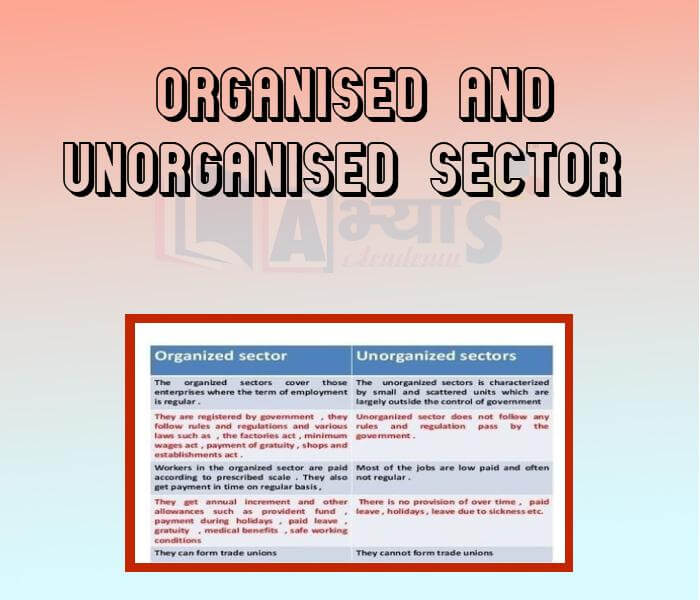Organised and Unorganised Sector












Organised and Unorganised Sector
Organised Sector: The organised sector covers those enterprises or places of work where the terms of employment are regular and people have assured work. It is called organised because it has some formal processes and procedures.
These enterprises are registered by the government and have to follow the rules and regulations framed by government under various laws like Factories Act, Minimum Wages Act, Payment of Gratuity Act, Employees' Provident Funds and Miscellaneous Provisions Act, Shops and Establishment Act etc.
Thus, workers in the organised sector have security of employment, work for a fixed number of hours and additional overtime wages if asked to work more. They get medical benefits and the management has to ensure facilities like clean drinking water and a safe working environment.
Some of these people may not be employed by anyone, but may work on their own but they too have to register themselves with the government and follow the rules and regulations. In some organisations, the workmen also get pension after retirement. They also get paid leave, payment for working on holidays and medical benefits.
Unorganised Sector: In contrast, the unorganised sector enterprises are not registered with the government. This sector characterised by small and scattered units which are largely outside the control of government and governmental rules and regulations are not followed. Workers get lower wages and there is no provision for overtime payment, paid holidays or paid leave due to sickness etc.
A large number of people doing jobs like street hawkers, repair workmen, domestic servants and similar other workmen come under unorganised sector in urban areas. In rural areas, unorganised sector comprises landless agricultural labourers, small and marginal farmers, share croppers and artisans (weavers, blacksmiths, carpenters,goldsmiths etc). Workmen can be asked to quit the job at any time without any reason being given and thus, employment is insecure. Casual workers and landless labourers in rural areas also fall in this category.
Protection of Workers in Unorganised Sector: The unorganised sector comprises mainly of workers who get irregular and low paid work, besides facing social discrimination. Their protection and supporting them is necessary for both economic and social equality.
Protection of unorganised sector workers can be accomplished through the following ways:-
In Urban areas, unorganised sector comprises mainly of _________________ | |||
| Right Option : D | |||
| View Explanation | |||
In India, large population is employed in : | |||
| Right Option : B | |||
| View Explanation | |||
In the rural areas, the unorganised sector mostly comprises of : | |||
| Right Option : D | |||
| View Explanation | |||
Students / Parents Reviews [10]
It was a good experience with Abhyas Academy. I even faced problems in starting but slowly and steadily overcomed. Especially reasoning classes helped me a lot.

Cheshta
10thAbhyas is a complete education Institute. Here extreme care is taken by teacher with the help of regular exam. Extra classes also conducted by the institute, if the student is weak.

Om Umang
10thMy experience with Abhyas academy is very good. I did not think that my every subject coming here will be so strong. The main thing is that the online tests had made me learn here more things.

Hiya Gupta
8thMy experience was very good with Abhyas academy. I am studying here from 6th class and I am satisfied by its results in my life. I improved a lot here ahead of school syllabus.

Ayan Ghosh
8thMy experience with Abhyas is very good. I have learnt many things here like vedic maths and reasoning also. Teachers here first take our doubts and then there are assignments to verify our weak points.

Shivam Rana
7thIt has a great methodology. Students here can get analysis to their test quickly.We can learn easily through PPTs and the testing methods are good. We know that where we have to practice

Barkha Arora
10thOne of the best institutes to develope a child interest in studies.Provides SST and English knowledge also unlike other institutes. Teachers are co operative and friendly online tests andPPT develope practical knowledge also.

Aman Kumar Shrivastava
10thAbhyas Methodology is very good. It is based on according to student and each child manages accordingly to its properly. Methodology has improved the abilities of students to shine them in future.

Manish Kumar
10thBeing a parent, I saw my daughter improvement in her studies by seeing a good result in all day to day compititive exam TMO, NSO, IEO etc and as well as studies. I have got a fruitful result from my daughter.

Prisha Gupta
8thA marvelous experience with Abhyas. I am glad to share that my ward has achieved more than enough at the Ambala ABHYAS centre. Years have passed on and more and more he has gained. May the centre flourish and develop day by day by the grace of God.
